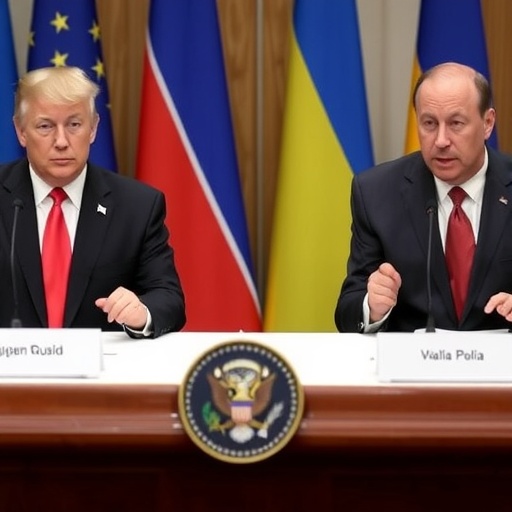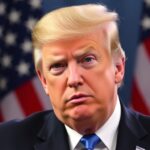In a dramatic escalation of tensions, the Trump administration has unveiled a sweeping package of new sanctions targeting key sectors of the Russian economy, just days after abruptly canceling a highly anticipated second summit intended to broker an end to the war in Ukraine. The move, announced by White House officials on Thursday, signals a hardening U.S. stance against Moscow amid accusations of bad-faith negotiations and continued military aggression.
The sanctions, which include restrictions on Russian energy exports, financial institutions, and oligarch assets, are designed to ramp up economic pressure on President Vladimir Putin’s regime. This comes as the conflict in Ukraine enters its third year, with reports of over 500,000 casualties and widespread devastation in eastern regions like Donetsk and Kharkiv. Trump‘s decision to abandon the summit—originally scheduled for Geneva—has drawn sharp criticism from allies and praise from hawkish lawmakers, underscoring the volatile state of international diplomacy.
Summit Collapse: Putin’s Demands Derail Peace Talks
The cancellation of the Russia-Ukraine summit, which Trump had personally championed as a potential breakthrough, was precipitated by irreconcilable demands from the Kremlin. Sources close to the negotiations reveal that Russian delegates insisted on Ukraine’s permanent neutrality, demilitarization of its eastern borders, and recognition of annexed territories like Crimea and parts of Donbas—conditions dismissed by Kyiv as tantamount to surrender.
“We went into these talks with an open mind, but Russia’s position was non-negotiable aggression,” said U.S. Secretary of State Mike Pompeo in a press briefing. “President Trump made the call to pull the plug when it became clear Moscow was using the summit as a stalling tactic to regroup its forces.” The first summit, held virtually in late 2023, had yielded minor humanitarian agreements, but expectations for the second were sky-high, with European leaders urging a ceasefire to avert a harsh winter for Ukrainian civilians.
Analysts point to intelligence reports of Russian troop buildups near the Belarus border as a key factor in the summit’s demise. Satellite imagery from the U.S. National Geospatial-Intelligence Agency showed over 100,000 additional personnel deployed since October, fueling fears of a renewed offensive. Ukrainian President Volodymyr Zelenskyy, in a televised address, expressed disappointment but solidarity with the U.S. decision: “We appreciate America’s resolve. Peace through strength is the only path forward.”
The fallout has rippled through diplomatic channels. NATO Secretary General Jens Stoltenberg warned that the summit’s failure could embolden authoritarian regimes worldwide, while French President Emmanuel Macron called for an emergency EU summit to coordinate responses. Domestically, Trump’s base has rallied behind the move, with polls from Pew Research indicating 62% approval among Republicans for tougher sanctions on Russia.
Unpacking the Sanctions: Targeting Russia’s Economic Lifelines
The new sanctions package, formalized under Executive Order 14000, represents one of the most aggressive actions against Russia since the war’s onset. Valued at an estimated $50 billion in immediate economic impact, the measures freeze assets of 200 Russian oligarchs and ban U.S. firms from dealings with state-owned entities like Gazprom and Rosneft. Energy sanctions are particularly stringent, prohibiting the import of Russian oil and gas derivatives, which could disrupt global supply chains already strained by the conflict.
“These aren’t just penalties; they’re a chokehold on the Kremlin’s war machine,” Trump declared during a rally in Florida. The sanctions also extend to secondary measures, penalizing any third-country entities that facilitate Russian trade evasion. Financially, major banks like Sberbank face exclusion from the SWIFT system, echoing 2022 restrictions but with broader scope. Economists from the Brookings Institution project a 15-20% contraction in Russia’s GDP over the next year if fully enforced.
- Energy Sector Hit Hard: Bans on Arctic LNG projects could cost Russia $10 billion annually, per Energy Department estimates.
- Oligarch Purge: Figures like Roman Abramovich and Oleg Deripaska see their U.S. holdings—worth billions—seized or frozen.
- Tech and Defense Curbs: Restrictions on semiconductor exports aim to hamstring Russia’s military-industrial complex.
Implementation will be overseen by the Treasury Department’s Office of Foreign Assets Control (OFAC), with initial waivers granted to allies like Germany for existing Nord Stream dependencies. However, critics argue the sanctions may inadvertently boost prices for American consumers, with gasoline potentially rising 20 cents per gallon in the coming months, according to AAA projections.
Reactions Pour In: From Kremlin Fury to Kyiv Gratitude
Moscow’s response was swift and incendiary. Russian Foreign Minister Sergey Lavrov labeled the sanctions “economic terrorism” and vowed retaliatory measures, including potential cuts to natural gas supplies to Europe. In a state media broadcast, Putin accused Trump of sabotaging peace for domestic political gain, claiming the U.S. president was eyeing re-election leverage amid midterm pressures.
“The West’s hypocrisy knows no bounds,” Lavrov stated in an interview with RT. “They preach dialogue but deliver ultimatums.” Russian stock markets plunged 8% on the announcement, with the ruble hitting a three-year low against the dollar. State Duma speaker Vyacheslav Volodin proposed a bill to nationalize foreign assets in Russia, escalating fears of tit-for-tat expropriations.
On the other side, Ukrainian officials hailed the sanctions as a lifeline. Zelenskyy’s foreign minister, Dmytro Kuleba, tweeted: “Trump’s bold action reaffirms U.S. commitment to Ukraine’s sovereignty. Together, we’ll end this invasion.” Aid from Washington has already surged, with $2.5 billion in military assistance allocated for Javelin missiles and drone technology in the latest package.
International voices are mixed. The UN Security Council held an emergency session where China’s ambassador abstained from condemnation, highlighting Beijing’s delicate balancing act as a Russian ally. In Congress, bipartisan support emerged, with Senate Foreign Relations Committee Chair Bob Menendez (D-NJ) praising the move: “It’s about time we squeeze Putin where it hurts—his wallet.” Yet, progressive Democrats like Rep. Ilhan Omar (D-MN) cautioned against escalation, warning of nuclear risks in the Black Sea region.
War’s Toll Deepens: Ukraine’s Frontlines Under Siege
As sanctions tighten, the human cost of the Russia-Ukraine war remains stark. The United Nations reports over 10,000 civilian deaths since February 2022, with infrastructure damage exceeding $400 billion. In Mariupol, once a bustling port city, satellite photos show 90% of buildings in ruins, displacing 1.5 million residents. Humanitarian corridors, a fragile achievement from the first summit, are now at risk amid renewed shelling.
Ukrainian forces, bolstered by Western arms, have held key lines near Kyiv and Odesa, but Russian advances in the south threaten grain exports vital to global food security. The World Food Programme warns of famine risks in Africa and the Middle East if Black Sea shipments halt, with wheat prices up 30% year-over-year. Trump’s sanctions indirectly address this by pressuring Russia to honor pre-war export deals, though enforcement remains challenging.
Military analysts from the RAND Corporation note that U.S. sanctions could degrade Russian logistics, with fuel shortages already reported in occupied territories. A recent battle in Bakhmut saw Ukrainian troops repel a 5,000-strong assault, but at the cost of 300 lives. Veterans’ stories, like that of Sergeant Olena Kovalenko, who lost a leg to a cluster munition, underscore the war’s brutality: “Every day is a fight for survival. These sanctions give us hope that justice is coming.”
Economically, Ukraine’s GDP has shrunk 35% since the invasion, reliant on $100 billion in international aid. The summit’s collapse dashed hopes for reconstruction funding, prompting Zelenskyy to appeal directly to Trump for a bilateral security pact modeled on NATO’s Article 5.
Global Ripples: Energy Crises and Diplomatic Shifts Ahead
The sanctions’ broader implications extend far beyond bilateral ties, reshaping global energy dynamics and alliance structures. With Russia supplying 40% of Europe’s gas pre-war, the curbs could accelerate the green transition but at a steep short-term cost—European households face 25% utility bill hikes this winter, per the International Energy Agency.
In the U.S., Trump’s strategy aligns with his “America First” doctrine, prioritizing domestic energy independence through increased LNG exports to Europe. Deals with Poland and the UK are projected to create 50,000 jobs in Texas and Louisiana alone. However, environmental groups like Sierra Club decry the reliance on fossil fuels, urging investment in renewables instead.
Looking forward, the administration hints at multilateral efforts, including a G7 summit in June to harmonize sanctions enforcement. Experts speculate on potential backchannel talks via Turkey, which mediated grain deals last year. If Russia blinks, a revised summit could emerge by fall; otherwise, escalation looms, with U.S. intelligence eyeing hybrid threats like cyberattacks on Western infrastructure.
For Ukraine, the path to victory hinges on sustained support. As Trump prepares for what he calls “the final push against Putin,” the world watches nervously. Diplomatic isolation of Moscow, combined with economic strangulation, may yet force concessions—but at what price to global stability? The coming months will test the resolve of leaders on all sides, with the stakes higher than ever.









